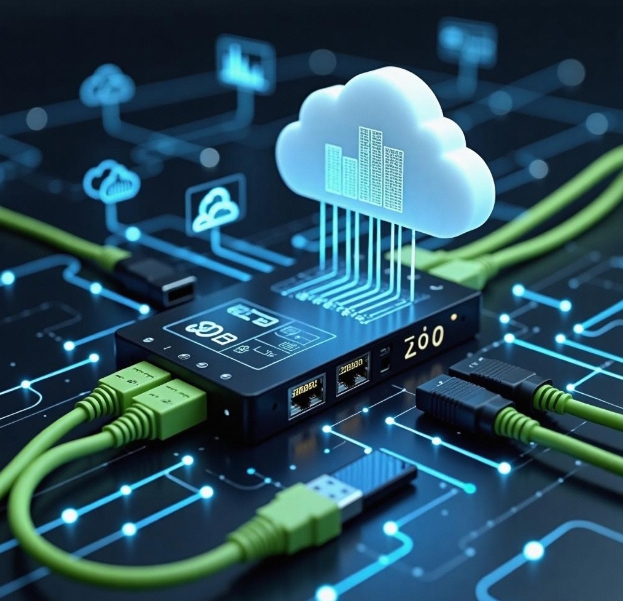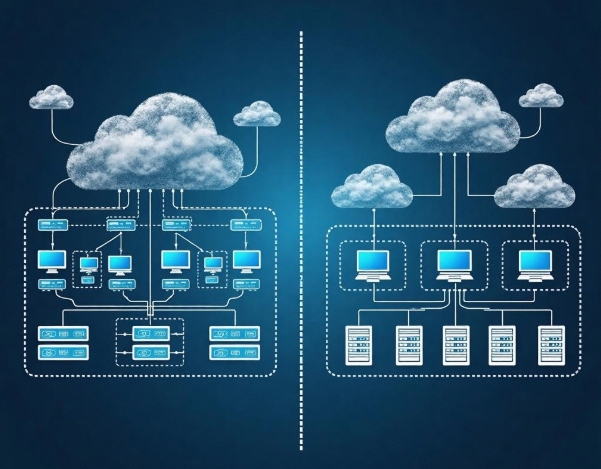Differences and Advantages of Cloud Computing Applications Compared to Traditional IT Architecture
- latest articles
- 1.DApp Development & Customization: Merging Diverse Market Needs with User Experience 2.Analysis of the Core Technical System in DApp Project Development 3.How to achieve cross-chain interoperability in Web3 projects? 4.How does the tokenization of points reconstruct the e-commerce ecosystem? 5.How to Set and Track Data Metrics for a Points Mall? 6.What is DApp Development? Core Concepts and Technical Analysis 7.Inventory of commonly used Web3 development tools and usage tips 8.Development of a Distribution System Integrated with Social E-commerce 9.Six Key Steps for Businesses to Build a Points Mall System 10.What is DApp Development? A Comprehensive Guide from Concept to Implementation
- Popular Articles
- 1.Future Trends and Technology Predictions for APP Development in 2025 2.Analysis of the DeFi Ecosystem: How Developers Can Participate in Decentralized Finance Innovation 3.From Zero to One: How PI Mall Revolutionizes the Traditional E-commerce Model 4.DAPP Development | Best Practices for Professional Customization and Rapid Launch 5.Recommended by the Web3 developer community: the most noteworthy forums and resources 6.From Cloud Computing to Computing Power Leasing: Building a Flexible and Scalable Computing Resource Platform 7.How to Develop a Successful Douyin Mini Program: Technical Architecture and Best Practices 8.Shared Bike System APP: The Convenient Choice in the Era of Smart Travel 9.How to Create a Successful Dating App: From Needs Analysis to User Experience Design 10.From Design to Development: The Complete Process of Bringing an APP Idea to Life
With the rapid development of information technology, cloud computing, as an innovative technology, is rapidly transforming business models across various industries. Cloud computing not only significantly enhances enterprises' computing and storage capabilities but also improves operational efficiency and reduces costs. Compared to traditional IT architectures, cloud computing offers distinct advantages and unique characteristics. This article will delve into the differences between cloud computing applications and traditional IT architectures and analyze the application advantages of cloud computing in various fields.
I. Overview of Traditional IT Architecture
Traditional IT architecture typically refers to computing and storage systems built on physical hardware resources. Enterprises purchase and maintain their own hardware equipment, such as servers, storage devices, and network devices, establishing their own data centers to provide autonomous IT services. Traditional IT architecture generally includes the following elements:
Physical Servers: Enterprises need to purchase, configure, and maintain physical servers. The computing power and storage capacity of each server are fixed, requiring enterprises to plan and procure based on demand.
Data Storage: Data storage typically relies on internal storage devices, such as disk arrays and tape libraries, which require maintenance by specialized technical personnel.
Network Equipment: Enterprise network architectures are usually composed of switches, routers, firewalls, and other devices to ensure secure and efficient data transmission.
Operations Management: Since hardware resources are purchased and maintained by the enterprise itself, operations management becomes more complex, requiring a sufficient technical team for system monitoring, troubleshooting, and upgrades.
The main characteristics of traditional IT architecture are high stability and strong controllability, but it also has certain limitations, especially in responding to rapidly changing market demands and technological developments, where traditional IT architecture often struggles to provide quick responses and flexible scalability.
II. Overview of Cloud Computing Architecture
Compared to traditional IT architecture, cloud computing architecture is a distributed computing model based on the internet. Users do not need to purchase and maintain physical hardware devices but instead obtain computing power, storage space, and application services on-demand from resources provided by cloud service providers. Cloud computing architecture typically includes the following key elements:
Virtualization Technology: Cloud computing uses virtualization technology to abstract physical resources (such as servers and storage) into virtual resources, enabling more efficient resource management and allocation. Virtualization allows multiple virtual machines to run on a single hardware unit, improving resource utilization.
Elastic Scaling: Cloud computing can dynamically adjust the scale and quantity of resources based on changes in user demand. Enterprises do not need to reserve large amounts of resources for peak demand in advance, avoiding resource waste.
Pay-as-You-Go Billing: Cloud computing adopts a pay-as-you-go model, where users pay for the resources they actually use. This billing model reduces the initial investment costs for enterprises and increases financial flexibility.
High Availability and Disaster Recovery Capabilities: Cloud computing platforms typically offer high availability and disaster recovery services, utilizing distributed data storage and multi-node redundancy designs to ensure service stability and data security.
The greatest advantages of cloud computing architecture lie in its flexibility, scalability, and efficiency, enabling enterprises to tackle various challenges in a rapidly evolving digital environment.
III. Differences Between Cloud Computing and Traditional IT Architecture
1. Differences in Resource Management
Traditional IT architecture typically relies on enterprises purchasing and managing their own hardware resources. Resource acquisition and configuration require advance planning, and resource expansion and adjustments are relatively difficult. When demand changes, enterprises may need to invest significant time and funds for upgrades and expansions. In contrast, cloud computing uses virtualization technology, with all resources provided and managed by cloud service providers, allowing users to make flexible adjustments based on demand and quickly respond to market changes.
2. Differences in Cost Structure
The costs of traditional IT architecture are mainly reflected in hardware procurement, data center construction, and hiring operations personnel. These costs are fixed and require long-term investment from enterprises. In comparison, cloud computing adopts a pay-as-you-go approach, where enterprises only pay for the computing resources and storage space they actually use. This model significantly reduces the upfront investment and operational costs for enterprises, making it particularly suitable for small businesses or startups that need to flexibly respond to market demand changes.
3. Differences in Flexibility and Scalability
Traditional IT architecture has poor flexibility, requiring enterprises to forecast demand and procure sufficient hardware resources. Once demand increases, enterprises may face resource shortages. In such cases, enterprises need to repurchase equipment and deploy it, a process that could take weeks or even months. Cloud computing, however, provides elastic scaling functionality, allowing enterprises to quickly increase or decrease computing resources as needed, greatly enhancing resource utilization and response speed.
4. Differences in Maintenance and Management
In traditional IT architecture, enterprises need to independently manage hardware, operating systems, databases, middleware, and other technical facilities, resulting in high operational complexity and labor costs. In contrast, cloud computing platforms are maintained and updated by service providers, freeing enterprises from managing underlying hardware and infrastructure and allowing them to focus on application and service operations. This difference lowers the technical barrier for enterprises and enables them to concentrate more on business innovation and development.
5. Differences in Security and Data Protection
In traditional IT architecture, data storage and network security must be ensured by the enterprises themselves. While enterprises can implement personalized security measures based on their needs, they also need to invest substantial resources in management. Cloud service providers typically offer highly secure infrastructure, including data encryption, identity authentication, backup and recovery functions, and continuously update and optimize their security strategies. Therefore, cloud computing platforms generally offer higher security than traditional IT architectures, especially large cloud service providers like Amazon AWS and Microsoft Azure, which have professional security teams and advanced technical measures.
IV. Advantages of Cloud Computing
1. Cost Efficiency
One of the most significant advantages of cloud computing is cost efficiency. Enterprises do not need to purchase expensive hardware equipment or build data centers, nor do they need to hire large IT teams for operations management. The pay-as-you-go model provided by cloud service providers allows enterprises to pay based on actual usage, significantly reducing capital expenditure, especially for small businesses that require flexible resource scaling.
2. Rapid Deployment and Flexible Scaling
The elastic scaling feature of cloud computing enables enterprises to quickly deploy new computing resources when needed and dynamically adjust resource scale based on demand. This flexibility is particularly important for responding to market changes and rapidly evolving digital environments.
3. High Availability and Disaster Recovery Capabilities
Cloud computing platforms typically employ distributed architectures with high availability and disaster recovery capabilities. Enterprises can use multi-region and multi-availability zone deployments provided by cloud service providers to enhance system reliability and ensure business continuity. Even if one data center fails, services can quickly switch to other regions, avoiding business interruptions due to single points of failure.
4. Innovation and Collaboration
Cloud computing not only provides robust infrastructure support but also offers rich development platforms and services for enterprises. For example, cloud computing can support applications of advanced technologies such as big data analytics, artificial intelligence, and the Internet of Things. It also makes remote work, collaboration, and sharing more efficient, allowing team members in different locations to share and edit documents in real-time, thereby improving work efficiency.
5. Environmentally Friendly
Since cloud service providers deploy efficient data centers globally and adopt environmentally friendly measures such as green energy, the energy consumption and carbon footprint of cloud computing are relatively low. For enterprises, this not only reduces energy costs but also enhances their corporate social responsibility image.
V. Conclusion
In summary, there are significant differences between cloud computing and traditional IT architecture in terms of resource management, cost structure, flexibility, maintenance management, and security. With its flexibility, scalability, cost efficiency, and high availability, cloud computing has become an important tool for driving digital transformation and business innovation. For enterprises, embracing cloud computing is an effective way to enhance competitiveness, reduce costs, and accelerate innovation. Of course, cloud computing is not a panacea; enterprises need to make careful decisions when choosing cloud computing services based on their business needs, technical capabilities, and security requirements.
Through continuous innovation and optimization, cloud computing will continue to drive digital transformation across various industries, while traditional IT architecture will more commonly appear in specific environments requiring high security and controllability. In the future, the combination of cloud computing and traditional IT architecture will become an important strategy for many enterprises to achieve technological upgrades and business development.
-

Applications and Challenges of Cloud Computing in the Internet of Things (IoT)
With the continuous advancement of information technology, cloud computing and t···
-

Integration of Cloud Computing and Artificial Intelligence: Enhancing Intelligent Applications
With the rapid advancement of technology, cloud computing and artificial intelli···
-

Data Security and Privacy Protection in Cloud Computing Applications
With the continuous advancement of information technology and the rapid developm···

 Blockchain
Blockchain












